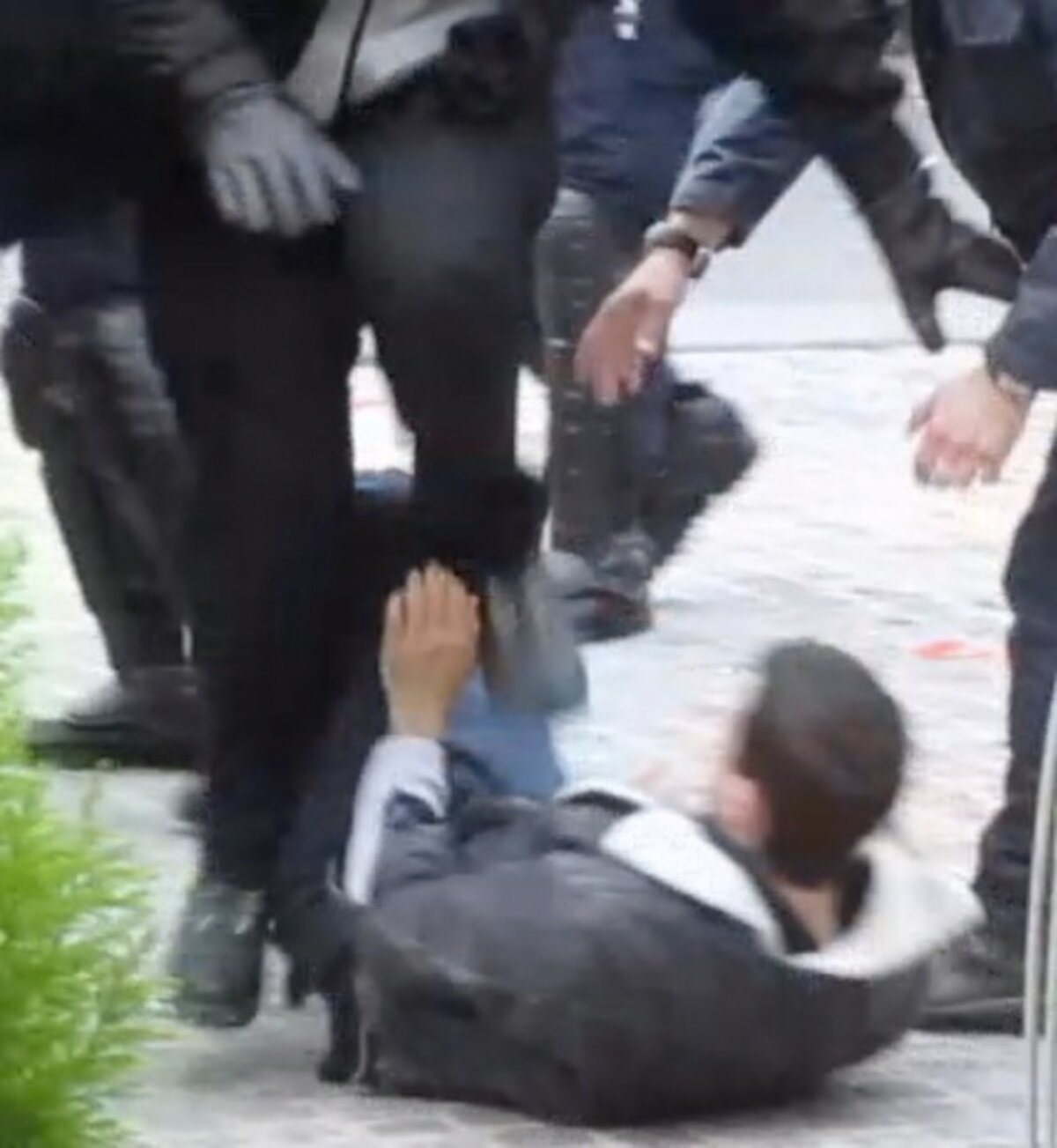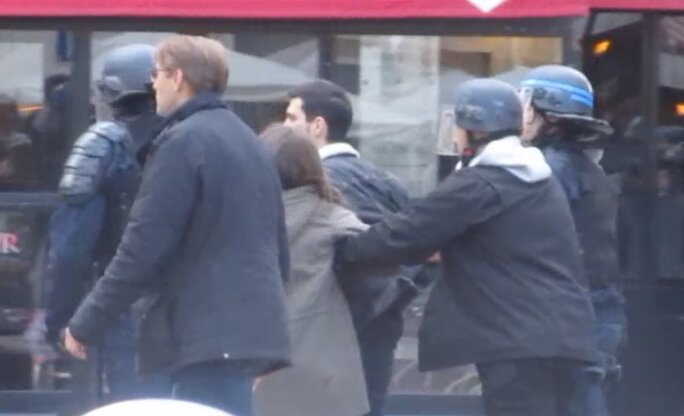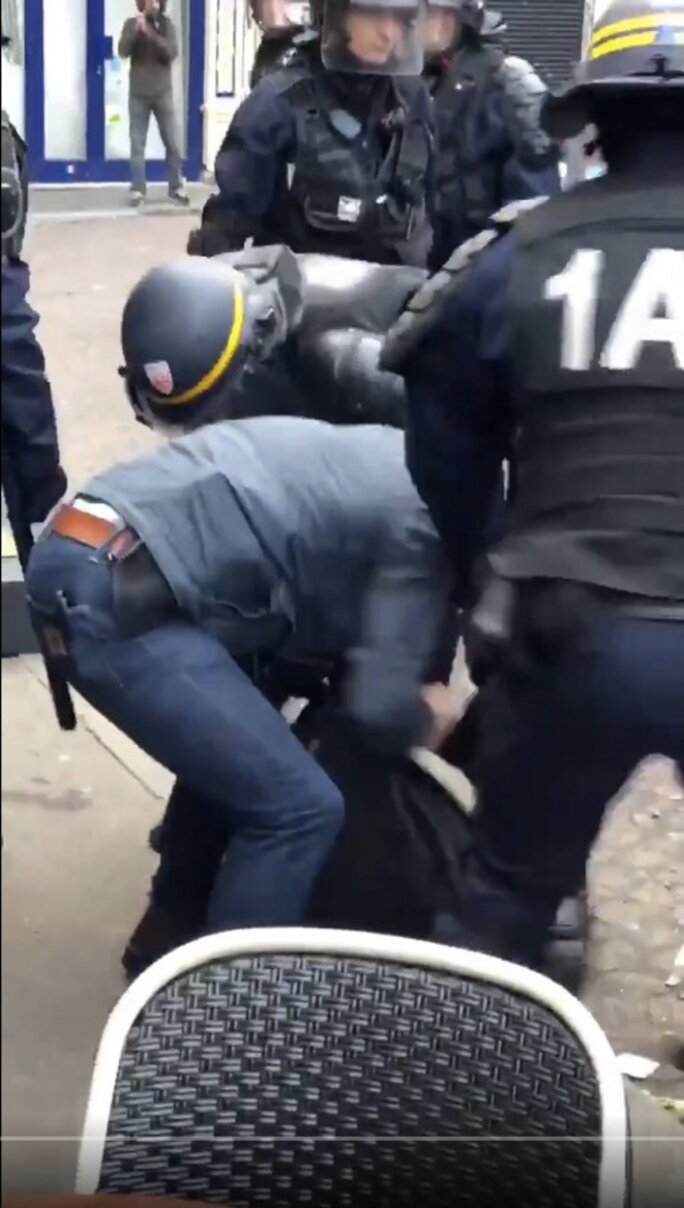After being brought into police custody on Friday, French presidential aide Alexandre Benalla continued to be questioned on Saturday as the scandal prompted by media revelations of video footage showing him beating up May Day demonstrators spread to what increasingly appears to be a high-level cover up of his thuggish behaviour and connivance by police officials, including those present at the scene of the assaults.
The French presidential office, the Élysée Palace, announced on Friday that dismissal proceedings had begun against Benalla whose post as deputy to President Emmanuel Macron’s cabinet chief, Patrick Strzoda, essentially involved ensuring the security on trips by the French head of state and his wife Brigitte.

Enlargement : Illustration 1

Meanwhile, Mediapart has obtained new video footage of Benalla’s violent behaviour (see further below) in a crowded square in the Latin Quarter of Paris on May 1st which shows how he led police to arrest a young man he had just beaten up, hitting him on the head and stamping with force upon his abdomen. Several videos of the events have emerged, showing Benalla wearing a police helmet, a police armband and carrying a walkie-talkie.
After the opening of a preliminary investigation on Thursday by the Paris public prosecution services citing “violence by a person in charge of a public service mission”, “usurpation” of police powers and police insignia, the interior ministry announced on Friday that it had launched an internal investigation into the events, led by the police internal inspection agency the IGPN.
Until French daily Le Monde initially revealed the scandal on its website on Wednesday evening, no such investigations were launched despite the fact that the violent events were swiftly made known to the French president and reportedly also to his interior minister, Gérard Collomb, as well as a number of senior officials, beginning with Benalla’s boss at the Elysée, Patrick Strzoda.
Strzoda, who has also been questioned by police, said that when he learnt on May 2nd that Benalla had assaulted demonstrators, he “just as soon” informed Macron, who was then on an official trip to Australia.
Crucially, France’s penal code stipulates that all civil servants, public service employees and anyone exercising a role of authority must report a crime or offence that they have been made aware of.
Until now, Macron has refrained from commenting on the scandal.
The French parliament’s cross-party law committee, made up of members of the lower house, the National Assembly, is to begin public questioning of interior minister Collomb on Monday when he will be the first witness to testify before the panel on the chain of events and responsibilities in the affair.
In a separate development, police have also begun questioning three ranking police officials who, just hours before Le Monde published its first revelations, illegally passed on to Benalla compromising CCTV footage of the scenes in the Latin Quarter square.
The French parliament’s cross-party law committee, made up of members of the lower house, the National Assembly, is to begin public questioning of interior minister Collomb on Monday when he will be the first witness to testify on the chain of events and responsibilities in the affair. The scandal has brought parliamentary debates on the government’s proposed constitutional reforms to a standstill, with MPs from both the rightwing and leftwing opposition describing the events variously as an “affair of state” and the result of Macron’s “prince-like” style of governing.
Many of them reacted angrily on Saturday after learning that Benalla disposed of a security pass for the National Assembly, obtained for him by Macron’s cabinet chief, Patrick Strzoda, but for reasons which are unclear. That was another example of the many surprising snippets of information emerging about a man who remains largely mysterious. Widely reported as being aged just 26, exactly how and why he was propelled to such an important post at the Elysée Palace is unclear. He is reported by several French media to have had a monthly salary of 10,000 euros, an official car, equipped with police-like blue flashing lights and siren, a chauffeur and, according to Le Monde, lodgings since earlier this month in a building belonging to the Elysée situated on the Quai Branly, close to the Eiffel Tower.
Benalla was officially present with CRS riot police at the place de la Contrescarpe on the late afternoon of May 1st in the capacity of “observer” of their crowd-control mission, along with a gendarmerie reservist and employee of Macron’s LREM party, Vincent Crase, who can also be seen on video footage energetically taking part in the violence. The two men have known each other for several years, and Crase has previously been occasionally summoned for missions at the presidential office.
The embedding of both Benalla and Crase alongside riot police units on May 1st implies the agreement of police authorities to their presence. The video footage shows clearly that the CRS officers at the scene were not only unconcerned by the violence inflicted before their eyes by Benalla and Crase, but appeared to act as if they were colleagues. One of the tasks of the IGPN investigation will be to establish who in the police hierarchy was responsible for allowing the pair to be able to become actively involved in the CRS operations.
Among the many issues so far unexplained is that of the responsibility of the presidential office, the Élysée Palace, which had authorised what Macron’s cabinet chief, Patrick Strzoda, called their “participation” in “an intervention with the police [authorities]”. Following the May 1st incidents, The Élysée showed extraordinary indulgence towards Benalla, who was disciplined with a two-week suspension from his duties without pay, and failed to report the assault.
Also a mystery is how Benalla, a former member of the French Socialist Party’s private security service, was given such a significant role as that of ensuring President Macron’s personal security. He was handed the job after having managed security management of Macron’s former En Marche ! movement (now the LREM party) during the presidential election campaign. Macron’s personal safety, like that of all French presidents, is already ensured by the dedicated presidential security group, the GSPR, which is made up of about 80 officers from the national police and gendarmerie forces.
Numerous images have begun circulating on social media since the scandal first broke on Wednesday evening which show Benalla in close proximity of Macron during the latter’s official engagements, apparently doubling as a bodyguard. While the Elysée Palace claimed he was given a desk job with internal security duties following the May 1st events, several recent pictures have emerged over the past 48 hours showing him in the company of Emmanuel and Brigitte Macron during different trips around France, including this month when he was also photographed on July 16th in the bus of the France football team as they paraded in Paris after their World Cup win.
Present at the place de la Contrescarpe on May 1st was health-sector union official Renaud Delacroix who has provided Mediapart with new video footage of the violence involving Benalla and Crase that afternoon. Delacroix, from the Sud Santé Sociaux union, said he and several friends went to the place de la Contrescarpe to meet up with others after the end of the May Day marches in Paris, arriving at the popular Latin Quarter square about half an hour before the violent scenes unfolded. “We were at first on the square itself, then we decided to have a drink at the bar Le Contrescarpe,” he told Mediapart. “The atmosphere was really relaxed at first. Certainly, there were a few CRS [officers] in the adjacent streets but people could move past.” He said tensions began when a group who had been on the May Day demonstrations – which were marred by incidents of violence in other parts of the capital – arrived.
“Twenty or so CRS immediately moved onto the square,” he continued. “They arrived and tear-gassed the people present, including at the [bar] terraces. The servers then got us inside the bar.”
As the events unfolded, Delacroix filmed the scene from inside the bar.
In the footage, Benalla can be seen attacking a young man for no apparent reason, hitting him and jumping and stamping with force on his abdomen. After the beating, the young man, who staggers in pain, joins a woman companion who, other video recordings have shown, was roughly manhandled by Benalla shortly before, when he had marched her along the pavement in a headlock.
The pair, visibly shocked at what had happened, are soon approached by Benalla, Crase (identifiable in the video as wearing jeans, with sun glasses propped on his closely shaved head), and two CRS riot police who Benalla had brought with him to arrest the young man. Also present is a man in civilian clothing (recognisable in the video from his brown hair and spectacles) who was identified by Le Monde on Friday as police officer Philippe Mizerski, a member of the senior staff of the ‘Department for Public Order and Circulation’, the DOPC.

Enlargement : Illustration 3

Benalla and the CRS officers led the man and woman – still unidentified – away from other demonstrators and to the facade of a bar on the square (time code 2’.08”), where they were joined by Crase and Mizerski. After a long period of inaudible conversation, the man is then placed on the ground and handcuffed, while his female companion is led away. The video footage ends at that point, but Renaud Delacroix, who said he remained for about another 20 minutes inside the bar opposite, said he witnessed the still handcuffed man being led off by police.
He said he did not see what happened next and does not know whether he was taken to a police station.
France-Info radio reported on Saturday evening that the assaulted man and his companion had now presented themselves to the investigation into the Benalla scandal, but have asked to be questioned at a later date. Their identities have so far not been made public.
More questions than answers as scandal unfolds
The traditional May Day marches and demonstrations in Paris on May 1st this year – which occurred just as Emmanuel Macron began a three-day official visit to Australia – were held in a highly-charged atmosphere. The police authorities announced they had put in place a “very reinforced” security plan, involving the presence of 1,300 police and gendarmerie officers. But, as in earlier demonstrations against the government’s economic reforms, part of the May Day march route was infiltrated by extremist groups, the so-called “black-bloc” anarchic mobs, who ransacked and set fire to commercial property and vehicles. Police unions subsequently denounced their professional hierarchy for not ordering in riot control officers more quickly to deal with the violent mobs.

Enlargement : Illustration 4

Taking to Twitter from Australia, Macron wrote: “I condemn with absolute firmness the violence that took place today and which have tainted the May 1st processions. Everything will be done so that those responsible are identified and held to account for their acts.” Whether the French president was aware that his security advisor Benalla and his associate Craze were present with crowd-control units in the streets of Paris has not yet been clarified.
Interviewed by Le Monde last week, Macron’s presidential cabinet chief Patrick Strzoda said he had been informed by Benalla “two days” before May 1st “that he wanted to take part in an intervention” by CRS riot police units “to see how a large demonstration was managed”. Strzoda then gave his authorisation for Benalla to join the policing operation as “an observer”.
Strzoda has stated that he was made aware of the incidents involving Benalla at the place de la Contrescarpe the following day.
Meanwhile, Macron’s official spokesman Bruno Roger-Petit, in a brief appearance before the media on Thursday, said that Benalla “acted in the framework of his leave” – meaning that he took the day off – when he joined the policing on May 1st. That comment was unusual given that it is most unlikely that an official with the presidential office, or even a ministry, would officially ask for leave on what is a public holiday. Roger-Petit added on Thursday that Benalla had “exceeded” the terms of the authorisation he had been given “by physically intervening to take part in an operation to maintain public order”.
Benalla’s associate Vincent Crase, an occasional collaborator of the presidential office, can be seen on the different videos now circulating in the media joining in the violent scenes and the arrest of the young man viciously assaulted by Benalla. In one of the published videos, shot by witness Taha Bouhafs, Crase can be seen in some images (see below) with what appears to be a handgun attached to his hip. Contacted by French daily Libération, both the interior ministry and the Paris police prefecture said that Crase does not have a permit to carry a firearm.

Enlargement : Illustration 5

Two days after the scenes at the Contrescarpe square, Patrick Strzoda wrote to Benalla to upbraid the latter for his involvement in the arrests and his “manifestly inappropriate behaviour”, and informed him that he and Crase, an employee of the LREM party, were suspended from their posts for two weeks without pay as of May 4th.
The President’s official spokesman described the disciplinary measure as being unprecedented at the Elysée (a claim which is uncertain), but this presentation appeared to be an attempt to hide a serious failure in the reaction of Benalla’s hierarchy. For, under Article 40 of the French penal code, anyone exercising a post of authority and who in the exercise of their duties learns of a crime or offence that has been committed is by law required to inform the public prosecution services. That clearly should have applied to the events involving Benalla and Crase at the place de la Contrescarpe.
The union representing French police commissaires (equivalent to superintendents in the UK, or captains in the US) stated that Benalla situation as an observer of the policing meant that, “he could only observe, in no case be an actor and even less than that use force”. Interviewed on Europe 1 radio, Denis Jacob, an official from police officers’ union Alternative Police CFDT commented: “What surprises me is that he wasn’t given civil protection equipment, and that he wore a police helmet.”
“An observer is placed under the responsibility of a commissaire in the field, and must stay with that commissaire,” said Jacob. “He is not there to intervene.”
In the case of Benalla, that role, according to a report in Le Monde, was given to Philippe Mizerski, (the man who can be seen in the video published with this article alongside Benalla and Crase, in civilian clothes), a senior officer with the ‘Department for Public Order and Circulation’, the DOPC.
-------------------------
- This article is based on several Mediapart reports in French which can be found here, here, and here.
English version with additional reporting by Graham Tearse


